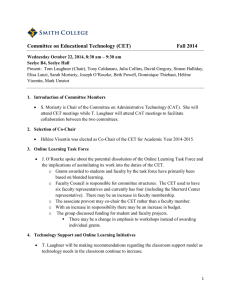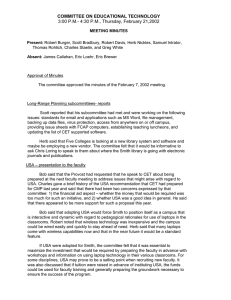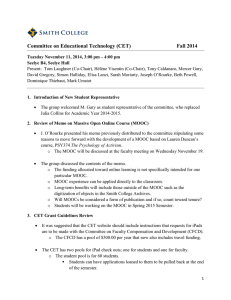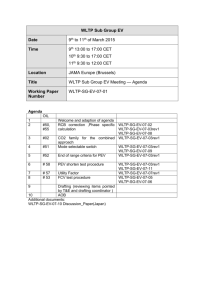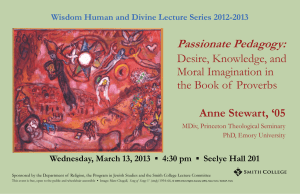Committee on Educational Technology (CET) Spring 2014
advertisement
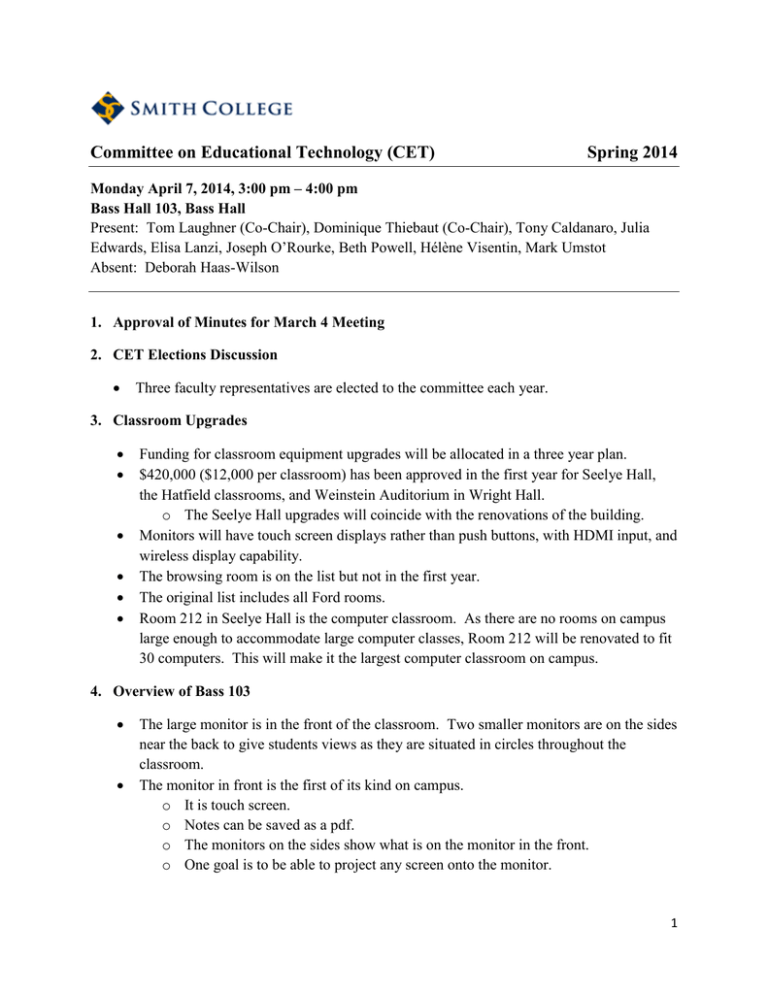
Committee on Educational Technology (CET) Spring 2014 Monday April 7, 2014, 3:00 pm – 4:00 pm Bass Hall 103, Bass Hall Present: Tom Laughner (Co-Chair), Dominique Thiebaut (Co-Chair), Tony Caldanaro, Julia Edwards, Elisa Lanzi, Joseph O’Rourke, Beth Powell, Hélène Visentin, Mark Umstot Absent: Deborah Haas-Wilson 1. Approval of Minutes for March 4 Meeting 2. CET Elections Discussion Three faculty representatives are elected to the committee each year. 3. Classroom Upgrades Funding for classroom equipment upgrades will be allocated in a three year plan. $420,000 ($12,000 per classroom) has been approved in the first year for Seelye Hall, the Hatfield classrooms, and Weinstein Auditorium in Wright Hall. o The Seelye Hall upgrades will coincide with the renovations of the building. Monitors will have touch screen displays rather than push buttons, with HDMI input, and wireless display capability. The browsing room is on the list but not in the first year. The original list includes all Ford rooms. Room 212 in Seelye Hall is the computer classroom. As there are no rooms on campus large enough to accommodate large computer classes, Room 212 will be renovated to fit 30 computers. This will make it the largest computer classroom on campus. 4. Overview of Bass 103 The large monitor is in the front of the classroom. Two smaller monitors are on the sides near the back to give students views as they are situated in circles throughout the classroom. The monitor in front is the first of its kind on campus. o It is touch screen. o Notes can be saved as a pdf. o The monitors on the sides show what is on the monitor in the front. o One goal is to be able to project any screen onto the monitor. 1 The classroom has 26 seats. o Two seats are higher for disability access. Macs are going to be brought into the classroom to diversify with the PCs. o Those PCs that will be replaced will be used for the campus-wide upgrades to Windows 7 from XP. 5. Horizon Report http://www.nmc.org/pdf/2014-nmc-horizon-report-he-EN.pdf The report is a collaboration between the New Media Consortium and Educause. Key Trends o Social Media is ubiquitous. Faculty are now pointing students to YouTube videos. o 45-54 year olds is the fastest growing segment on Facebook. o 55-64 year olds is the fastest growing segment on Twitter. o Hybrid Learning There is an increasing number of collaborative tools online. o Learning Analytics – the rise of data-driven learning and assessment Every single button pushed in a Coursera course is tracked. Virtually no one plays a course video in real time. The drop out rate is tracked. o There is a shift from students as consumers to students as creators. o The group discussed 3D printers as appropriate use of CET grant funds. o Agile Approaches to Change There is a move toward innovative teaching and learning. o Evolution of Online Learning – personalizing the online experience Challenges for Higher Education o Faculty have a low digital fluency. o There is a relative lack of rewards for teaching. o There is competition from new models of education. o The completion rate for online classes that are free is about 12%, while the completion rate for those who purchase a certificate ($50) is about 46%. o Expanding Access Developing countries have issues with accommodation. o Keeping Education Relevant Emerging Technologies and Important Developments o Flipped Classrooms o Learning Analytics 2 o 3D Printing o Games and Gamification Student retention is higher when games are involved. o Quantified Self o Virtual Assistance 6. Demonstrations Espresso Remind101 o Text reminders can be sent to students who provided their telephone numbers when they signed up. The numbers cannot be seen by the teacher. 7. CET Proposal: Richard Olivo The group discussed and approved the proposal for a LabChart 8 software license with Spike Histogram for $2,100.00. 3
